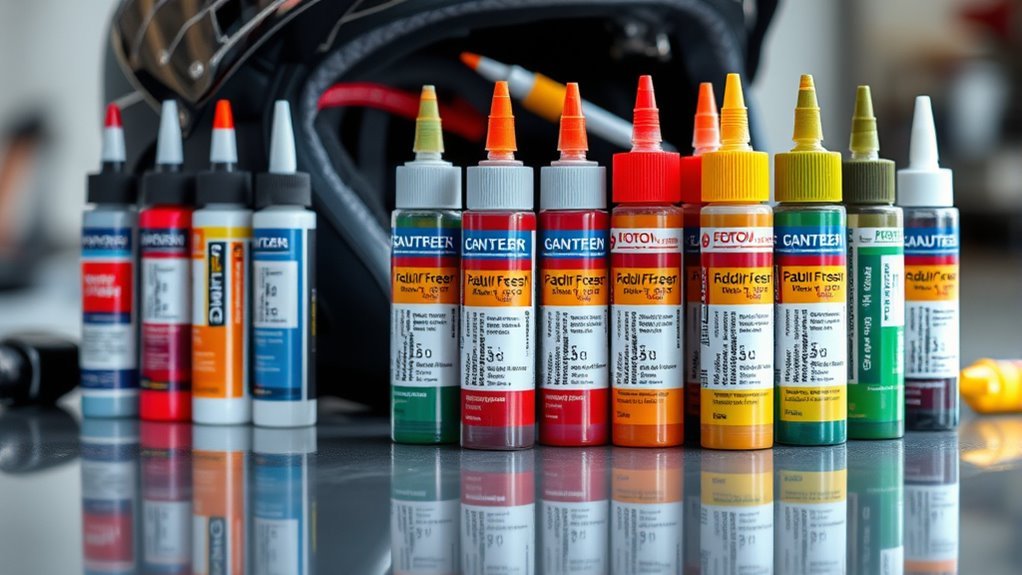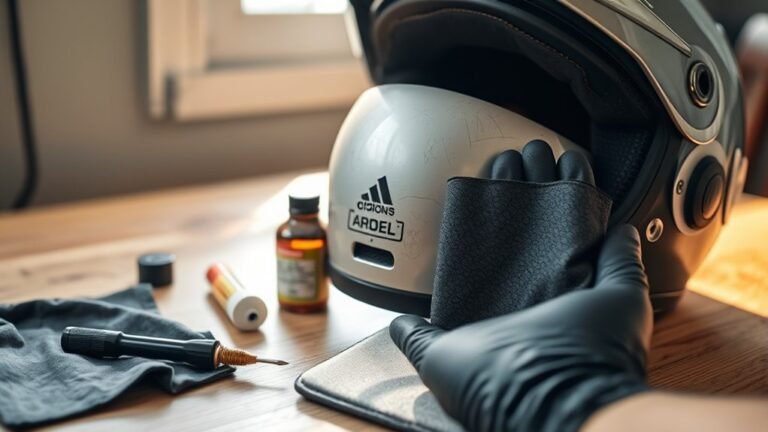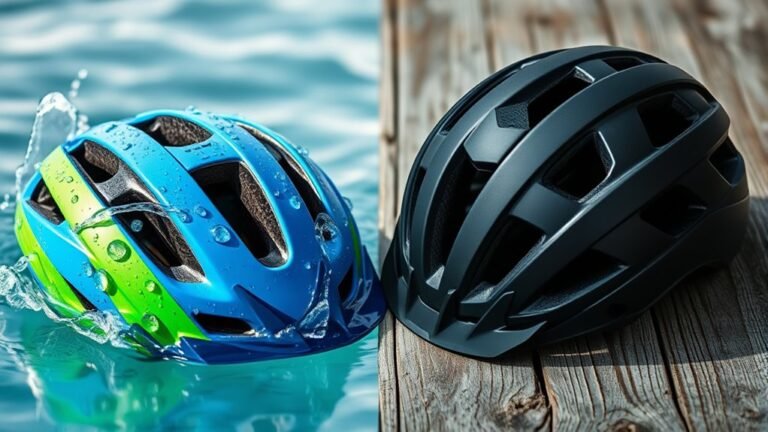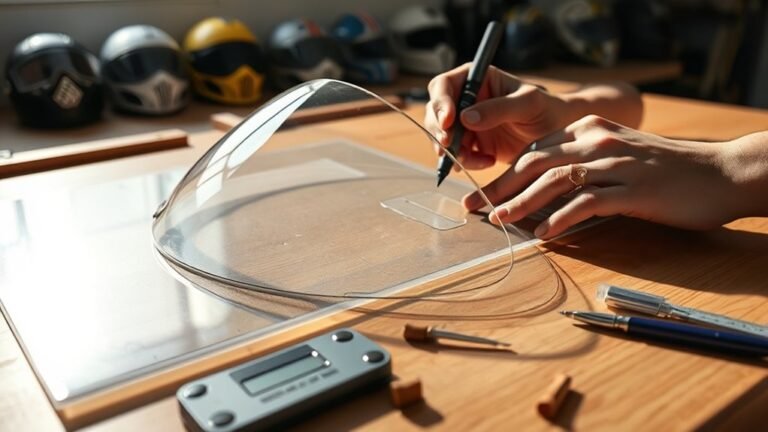Best Glues and Adhesives for Helmet Assembly
For helmet assembly, the best adhesives depend on your needs. Epoxy resins offer strong, durable bonds for metal and plastic, while cyanoacrylate provides quick adhesion for non-flexible joints. Polyurethane adhesives balance flexibility and impact resistance, perfect for varied conditions. Silicone is excellent for water resistance and shock absorption. Choosing the right adhesive enhances safety and performance, ensuring helmet integrity during use. Learn more about specific adhesive applications and benefits for ideal assembly.
Types of Adhesives for Helmet Assembly
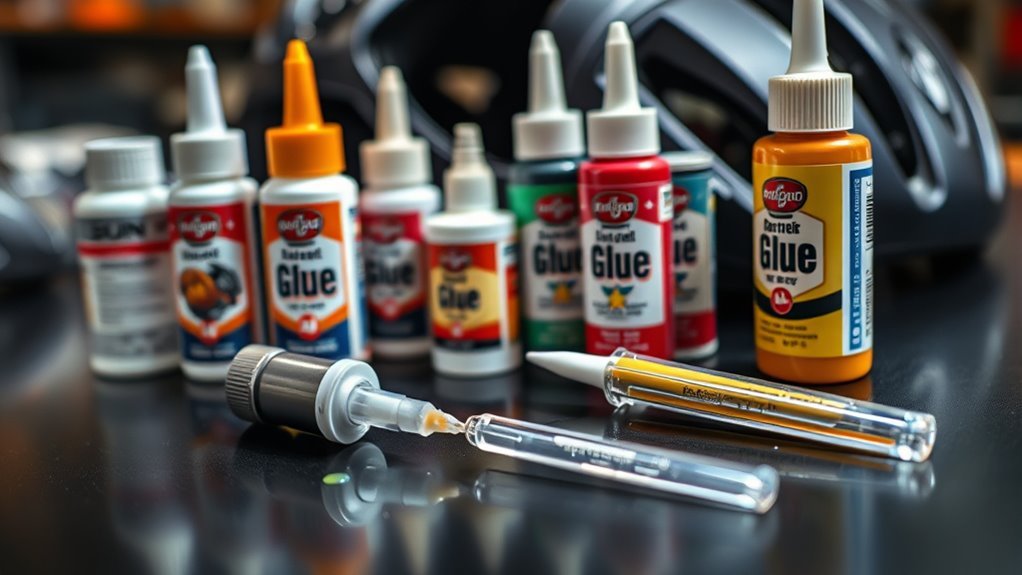
When assembling a helmet, it’s essential to choose the right adhesive, as different types serve specific purposes and materials. You’ll encounter cyanoacrylate, known for its rapid bonding properties, ideal for quick repairs. Polyurethane adhesives offer flexibility and durability, making them suitable for impact-resistant applications. For a robust bond, epoxy adhesives leverage superior adhesive properties, ensuring long-lasting connections between various components. Each adhesive employs distinct bonding techniques, such as surface activation or chemical curing, which can appreciably affect the assembly’s integrity. Understanding these options empowers you to select the best adhesive for your helmet, ensuring safety and performance. By aligning adhesive choice with the materials used, you can maximize strength and functionality, allowing for the freedom needed in demanding environments.
Epoxy Resins: Strength and Versatility
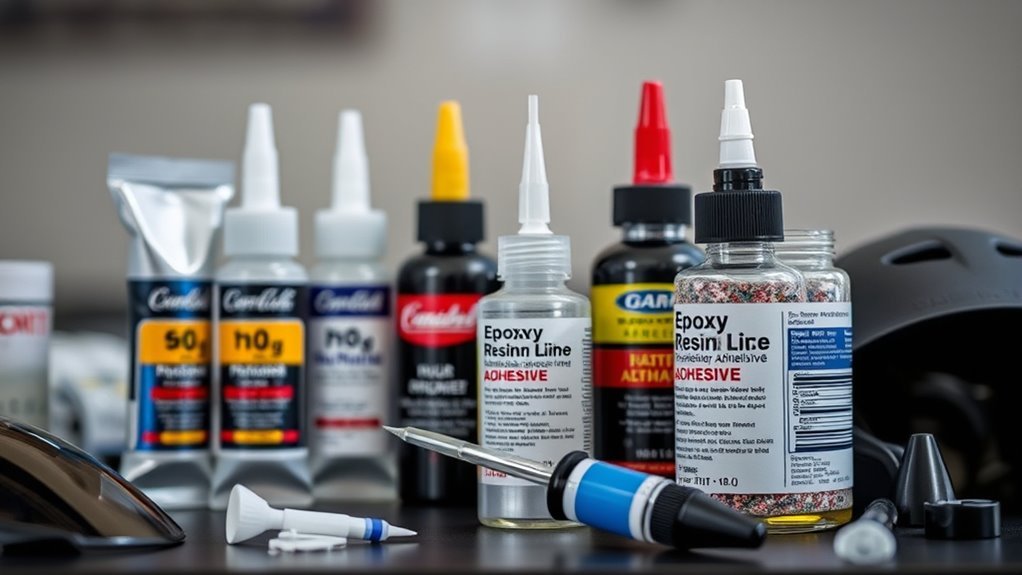
Epoxy resins stand out as one of the most robust options for helmet assembly, combining high strength with versatility across various materials. Their superior bonding capabilities make them ideal for a range of epoxy applications, from plastics to metals, ensuring a durable and reliable assembly. When you engage in epoxy curing, the chemical reaction transforms the resin into a solid, resilient form, enhancing its structural integrity. This process not only provides excellent adhesion but also maintains flexibility, essential for helmets that endure impact. Furthermore, epoxy resins resist moisture and temperature fluctuations, further extending their lifespan. By choosing epoxy, you’re investing in a long-lasting solution that empowers your helmet’s performance, ensuring safety without compromising on freedom of movement.
Cyanoacrylate (Super Glue): Quick and Strong Bonds
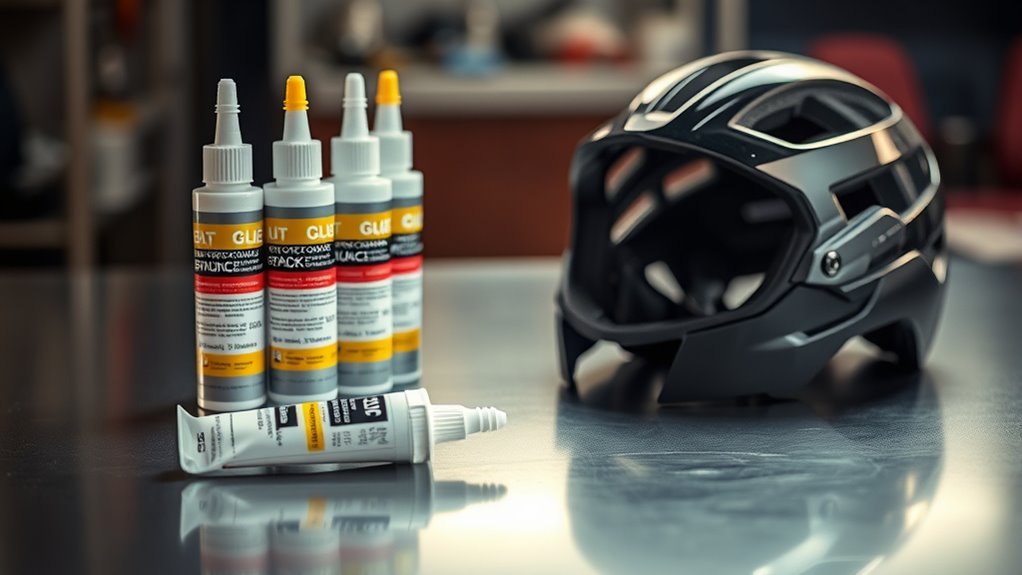
Although often used in household repairs, cyanoacrylate, commonly known as super glue, is also a powerful adhesive for helmet assembly due to its rapid curing time and strong bond strength. When working with diverse bonding materials like plastics, metals, and composites, super glue applications excel in providing immediate adhesion. Its ability to bond quickly minimizes assembly time, making it ideal for projects requiring efficiency. However, it’s crucial to verify surfaces are clean and fit tightly for best results. Keep in mind that while super glue offers impressive strength, it’s best suited for non-flexible joints. For those who value efficiency and reliability in helmet assembly, cyanoacrylate stands out as a go-to adhesive choice.
Polyurethane Adhesives: Flexibility and Durability
Polyurethane adhesives offer a unique combination of flexibility and durability, making them a strong choice for helmet assembly. Understanding their characteristics and application techniques is essential for peak performance. You’ll find that these adhesives not only enhance bond strength but also provide resilience against environmental factors.
Characteristics of Polyurethane Adhesives
When selecting an adhesive for helmet assembly, understanding the characteristics of polyurethane adhesives is essential due to their superior flexibility and durability. These polyurethane characteristics make them ideal for a variety of applications. Here are some key features to contemplate:
- Adhesive Flexibility: They maintain flexibility under varying temperatures, adapting to movements.
- Strong Bonding: Polyurethane adhesives create robust bonds with various materials, ensuring helmet integrity.
- Moisture Resistance: They resist water and humidity, preventing degradation over time.
- Chemical Resistance: These adhesives withstand exposure to chemicals, enhancing longevity in harsh environments.
Incorporating these traits can considerably improve the performance and lifespan of your helmet assembly, providing the freedom and durability you need.
Application Techniques and Tips
Mastering application techniques for polyurethane adhesives can greatly enhance the effectiveness of your helmet assembly. To guarantee a strong bond, focus on surface preparation, application consistency, and curing time. Here are some essential adhesive tips to keep in mind:
| Application Technique | Key Tips |
|---|---|
| Surface Preparation | Clean and dry surfaces |
| Adhesive Application | Even, controlled layers |
| Curing Process | Allow full cure time |
| Environmental Factors | Avoid extreme temperatures |
Benefits for Helmet Assembly
In the domain of helmet assembly, the choice of adhesive plays an essential role in ensuring safety and performance. Polyurethane adhesives offer distinct advantages that align with rigorous safety standards. Here are four key benefits:
- Flexibility: These adhesives can withstand vibrations and impacts without cracking.
- Durability: They resist environmental factors, ensuring long-lasting bonds under various conditions.
- Adhesive Testing Compliance: Polyurethane adhesives often meet stringent adhesive testing protocols, confirming their reliability in critical applications.
- Weight Efficiency: They provide strong bonds without adding significant weight, vital for helmet performance.
Silicone Adhesives: Water Resistance and Shock Absorption
Silicone adhesives offer exceptional water resistance, making them ideal for helmets exposed to various environmental conditions. Their unique formulation allows for effective sealing, preventing moisture ingress that could compromise structural integrity. Additionally, these adhesives excel in shock absorption, enhancing the helmet’s ability to disperse impact forces during collisions.
Water Resistance Properties
While choosing an adhesive for helmet assembly, it’s crucial to take into account water resistance properties, particularly when dealing with silicone adhesives. These adhesives not only form effective moisture barriers but also enhance durability against environmental elements. Here are key factors to bear in mind:
- Waterproof Coatings: Confirm the adhesive has waterproof coatings to prevent moisture penetration.
- Cure Time: Evaluate the cure time; faster curing can reduce exposure to water.
- Flexibility: Look for adhesives that maintain flexibility post-cure, which helps in adjusting to temperature changes.
- Temperature Resistance: Verify the temperature resistance to guarantee performance in varying conditions.
Shock Absorption Benefits
When selecting adhesives for helmet assembly, understanding shock absorption benefits is crucial, especially since these properties can greatly enhance safety. Silicone adhesives provide superior shock resistance, making them ideal for impact protection in helmet construction. Their unique formulation allows them to absorb and dissipate energy during an impact, reducing the force transmitted to the wearer’s head. This characteristic not only mitigates potential injury but also contributes to the overall durability of the helmet. Additionally, silicone’s flexibility guarantees that the adhesive maintains its integrity over time, even under varying conditions. By choosing silicone adhesives, you’re investing in a reliable method to enhance your helmet’s performance, guaranteeing that freedom on the road doesn’t compromise safety.
Choosing the Right Adhesive for Your Helmet Project
Selecting the right adhesive for your helmet project is essential, as the material and intended use greatly impact performance and safety. To guarantee ideal helmet safety, consider these design considerations in your adhesive choice:
Choosing the correct adhesive for your helmet is crucial for ensuring safety and performance.
- Material Compatibility: Make sure the adhesive bonds well with helmet materials like polycarbonate or fiberglass.
- Cure Time: Select adhesives with appropriate curing times for your project timeline.
- Flexibility: Choose flexible adhesives that can absorb impacts and allow for helmet movement.
- Temperature Resistance: Confirm the adhesive withstands varying temperatures to maintain bond integrity.
Frequently Asked Questions
How Long Does It Take for Adhesives to Cure Fully?
Adhesive cure time varies widely, typically taking anywhere from a few hours to several days for full strength. It’s essential to follow manufacturer guidelines, as each adhesive has specific requirements for ideal adhesive strength. Factors like temperature, humidity, and surface preparation can also affect cure time. If you want reliable results, be patient and allow adequate time for the adhesive to reach its maximum performance before subjecting it to stress or loads.
Can I Use Multiple Types of Adhesives on One Helmet?
Yes, you can use multiple types of adhesives on one helmet, but you need to take into account adhesive compatibility. Different adhesives may have varying bonding strengths and chemical compositions, which can lead to weakened joints if they interact negatively. It’s essential to verify that the adhesives you choose are compatible with each other to maintain structural integrity. Always test on a small area first to avoid compromising your helmet’s performance and safety.
Are There Any Safety Precautions When Using Adhesives?
When using adhesives, you should always wear appropriate safety gear, like gloves and goggles, to protect yourself from harmful chemicals. Guarantee proper ventilation in your workspace to avoid inhaling fumes, which can be hazardous. Follow the manufacturer’s instructions carefully, as they often include specific safety guidelines. It’s essential to allow adequate curing time in a well-ventilated area, guaranteeing both your safety and the effectiveness of the adhesive. Your well-being is paramount.
What Is the Shelf Life of Common Helmet Adhesives?
The shelf life of common adhesive types varies considerably. For instance, epoxy adhesives generally last around 1-2 years when stored properly, while cyanoacrylate adhesives can degrade within 6-12 months after opening. Polyurethane adhesives often maintain their effectiveness for 1-2 years as well. Always check the manufacturer’s guidelines, as factors like temperature and moisture can impact longevity. For peak performance, verify that you’re using adhesives within their recommended shelf life.
How Do I Properly Clean Surfaces Before Applying Adhesive?
Before applying adhesive, you’ve gotta treat your surfaces like a canvas before painting. Start with surface preparation by removing dust and grease using isopropyl alcohol or a suitable solvent. Scrub with a lint-free cloth, guaranteeing no residue remains. For porous surfaces, consider light sanding to enhance adhesion. This meticulous cleaning method not only guarantees a strong bond but also grants you the freedom to create a solid, durable assembly without worries about failure later on.
